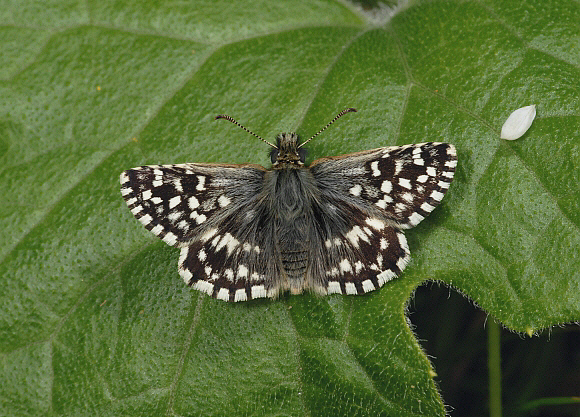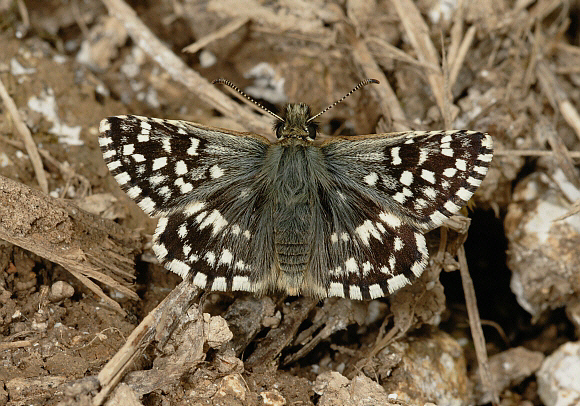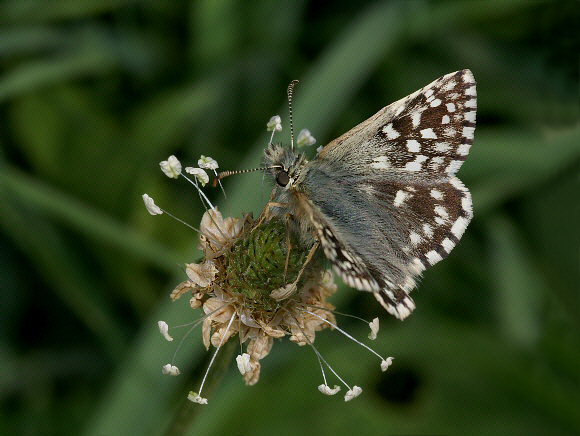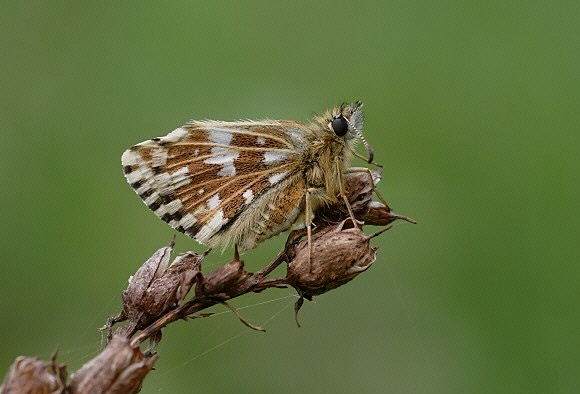 Grizzled Skipper Pyrgus malvae, male, Stockbridge Down, Hampshire – Adrian Hoskins
Grizzled Skipper Pyrgus malvae, male, Stockbridge Down, Hampshire – Adrian Hoskins
Introduction
There are about 50 known species in the genus Pyrgus, which has representatives in North, Central and South America, and in temperate Asia, as well as in Europe. The genus is instantly recognisable from the pattern of squarish white spots on a grizzled greyish ground colour, and by the prominent chequered fringes to the wings. All Pyrgus males have the basal half of the forewing costa folded back. Within the fold are hundreds of specialised scales called androconia, from which pheromones are disseminated to entice females into copulation.
The Grizzled Skipper flies very rapidly and erratically just above the surface of the ground, making it difficult to follow in flight. It is easily overlooked and certainly under-recorded. Transect analysis however provides evidence that the butterfly has declined in numbers in the last 20 years, and it is now regarded as a localised and fairly scarce species.
It is distributed throughout most of Europe but absent from Scotland, Ireland, northern Scandinavia and most Mediterranean islands. Beyond Europe it occurs from northern Turkey, across temperate Asia to northern China and Korea.
Confusingly the butterfly has undergone many name changes, being originally known as the Marsh Fritillary, a name that is now applied to a totally different insect in the Nymphalidae ! Other former names include “Mr Dandridge’s Dark Fritillary”, “Spotted Skipper” and “The Grizzle”.
The sexes can be distinguished easily – males have a fold along the leading edge of the forewings. This fold contains androconia which release pheromones to entice females into copulation.
Both sexes are prone to variation in the size and extent of the white markings. The ground colour is black when the butterflies are freshly emerged, but soon fades to a dark earthy brown. A recessive gene causes the periodic appearance of an aberrant form at some sites. This form, known as taras, has the white markings on the forewings greatly elongated and enlarged.
The Grizzled Skipper cannot be mistaken for any other species in Britain, but in continental Europe there are several similar Pyrgus, Spialia and Muschampia species with which it can be confused.
 Grizzled Skipper Pyrgus malvae, male, Stockbridge Down, Hampshire – Adrian Hoskins
Grizzled Skipper Pyrgus malvae, male, Stockbridge Down, Hampshire – Adrian Hoskins
Habitats
In Britain this species is widespread throughout the central and southern counties, but it’s range has contracted dramatically in recent years. It is now very localised, but can still be found in reasonable numbers on many chalk grassland sites. Small colonies also persist in certain woodlands, where it breeds in clearings, and along the edges of sunny forest tracks. Other habitats include scree slopes, railway cuttings and embankments, abandoned quarries, spoil heaps and limestone pavements.
Grizzled Skippers are always found in sheltered and well drained locations. Their breeding sites are characterised by having substantial areas of broken ground such as rabbit scrapes or eroded banks. These areas of bare soil encourage germination of the caterpillar’s foodplants and provide the warm micro-climate which is essential to the butterfly.
Grizzled Skipper Pyrgus malvae, male, Magdalen Hill Down, Hampshire – Adrian Hoskins
Lifecycle
The flight season varies according to climatic conditions in early spring. In forward seasons Grizzled Skippers can appear in early April, but they may not emerge until May in a cool or wet spring. Their numbers tend to build up gradually throughout May, and in late seasons they can often still be found in mid-June. In Europe a partial 2nd brood emerges in August, but records of a 2nd brood in Britain are extremely rare.
The greenish white dome-shaped eggs are laid singly on the undersides of leaves of wild strawberry Fragaria vesca, creeping cinquefoil Potentilla repens or agrimony Agrimonia eupatoria. More rarely young suckers of bramble Rubus fruticosus may be used. The eggs hatch after about 10 days.
When small the caterpillar is yellowish and rests under a thin veil of silk spun over the midrib on the upper surface of leaves. It leaves a characteristic pattern of little blotches nibbled out of the cuticle. When older it lives within a folded leaf spun together with a few strands of silk. The mature larva is green with narrow brown stripes along the back and sides.
Pupation takes place in August. The pupa is formed within a thin net-like cocoon spun near the base of the foodplant. It is very distinctive, with the abdomen and thorax dark brown, and the wing cases greenish white. The pupal stage lasts from August until the following April or May.
Adult behaviour
 Grizzled Skipper Pyrgus malvae, male perching on ribwort plantain – Adrian Hoskins
Grizzled Skipper Pyrgus malvae, male perching on ribwort plantain – Adrian Hoskins
The butterflies are extremely active, zigzagging or buzzing erratically in tight circles just above the surface of the ground. They are very difficult to track, and can easily be mistaken in flight for large flies. Neither sex tends to ever stray more than a few metres from their established breeding areas, so consequently it can take many years for the butterfly to colonise new sites.
Grizzled Skippers are usually seen in small groups, with 2 or 3 males having overlapping territories, typically in sheltered pockets at the bottom of hillsides. Each male habitually perches on a favoured leaf or stone – a territorial lookout post from which it will instantly dart up to challenge any fly, bee or butterfly that comes within range. When 2 males meet, they spiral rapidly together to a height of about 2 metres, after which each returns to it’s original perching place.
When a male intercepts a female, he flies close behind her until she settles on the ground. He lands alongside and then buzzes excitedly around her, wafting his pheromones over her antennae to try and entice her to copulate. If she is receptive she raises her wings, allowing the male to move into position alongside her. The male then curves his abdomen around to make sexual contact. The pair then readjust position to face away from each other. Copulation takes place in the late morning and lasts for about an hour during which time both sexes generally keep their wings fully outspread.
In overcast but warm weather the butterflies commonly bask on bare ground or on small stones but in sunny conditions they spend most of their time buzzing from flower to flower, nectaring avidly at bird’s foot trefoil, bugle, dandelion, ground ivy, violets, daisies, buttercups and hawkbit.
In late afternoon they go to roost on dead flower-heads, particularly favouring St John’s wort and marjoram, but will also roost on grass heads or at the tips of bramble sprigs.

Pyrgus malvae, female roosting on St John’s wort, Magdalen Hill Down – Adrian Hoskins

Pyrgus malvae, female roosting on dandelion, Magdalen Hill Down, Hampshire – Adrian Hoskins
